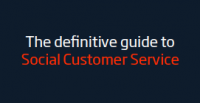
In this guest blog Conversocial share eight ways to give your social service a fresh start in 2014.
2013 was a year of change and growth for social customer service, with brands implementing more established social care strategies. But there’s still room for improvement. Done properly, social media gives customer service the opportunity to build brand advocacy and has the potential to drive revenue through both increased sales and reduced customer attrition, whilst massively increasing customer insight.

In an always on and real-time messaging world, consumers expect far more than they have before. Responding slower than consumers expect–or even neglecting to answer social complaints at all–will result in consumers abandoning brands. Entering 2014, brands must recognize that social media has become a mainstream customer service channel, and ensure that a well resourced and thought out social care strategy is in place.
1. Fully embrace the shift from private to public customer service
The transition of communication from private to public channels makes social customer service fundamentally different from traditional customer service. Systems built for the old paradigm of one email chain, one customer, and one ticket do not work when a conversation can pass seamlessly between private and public. If brands embrace this core concept they can benefit from some of the best PR out there – issue resolution in a public forum – but to do this you must know who you are talking to.
2. Build a single view of your social customer
For years, all online identification mechanisms were not only completely separate from real identity, but were also unconnected to each other. Because of this, companies have been struggling to obtain a 'single view’ of the customer for decades. Building a social identity has the potential to tie all of these details together. If you can tie the data together – not just between customer service channels, but at all points where your business touches a customer – it gives the ability to deliver completely personalized service. Consumers expect a joined-up seamless interaction, therefore this should be a key consideration for brands going into 2014.
3. Take advantage of the rise in mobile use
The shift from the use of desktop computers to smartphones is changing the types of interactions that customers have with companies. The immediacy of social platforms represents a real opportunity for companies to engage with customers, potentially at the point-of-purchase. Surprising and delighting the consumer in real-time helps build brand advocates – something that is business critical in the over-saturated consumer markets.
4. Invest more time in training customer service reps on social
The dangers of messing up a customer service conversation in a viral medium means that the training and processes for agents need to be very different from traditional customer service. The potential for negative impact from service being below consumer expectations is just too high. Altimeter did a review of all of the social media crises they could find between 2001 and 2012, finding not only that the leading cause of social media crises were negative experiences, but also that 76% of these crises would have been preventable with proper management. A clear focus on agent training will help eradicate this as a potential problem area.
5. Implement processes and plans for better internal teamwork and workflows
Providing social customer service for the enterprise means handling large volumes of interactions across numerous channels. By using specialized tools to help route and prioritize to the right agent, you can make sure that the same customer deals with the same customer service rep. This leads to greater efficiency, reduced response times, better case resolution and higher satisfaction rates.
6. Build out your social customer service platform offerings
The scale of social customer service is growing. Your customers now voice their questions, queries and complaints across a multitude of social platforms. A recent study from Pew Internet found that some 42% of online adults now use multiple social networking sites. Of course, it’s your responsibility to be wherever your customers are. In other words, it might be time to move past social customer service on just Twitter and Facebook. For example Google+ now is considered by many to be the 3rd most popular social network for consumers. If brands don’t yet have a customer service presence on this platform, 2014 has to be the year this changes.
7. Integrate social customer service into your contact center
2014 should be the year that social media moves firmly into the contact center. We saw signs of this in 2013, with brands acknowledging the importance of having social-savvy contact centers; this year we should see an even stronger movement in this direction. Therefore integrating with popular systems to exchange information in a multi-channel support environment is essential for any forward thinking business. Focus on case management, CRM and contact center ‘stacks’ as a starting point.
8. Use social customer service data to deliver actionable business insight
Social customer service delivers a wealth of data that gives real insight into your business ecosystem. Make it easy for managers and agents to drill down on metrics and see the underlying data for informed decision making.
Learn everything you need to know to deliver first class social customer service by downloading our copy of ‘The Definitive Guide to Social Customer Service’ below.
6th January 2014 by Harry Rollason

